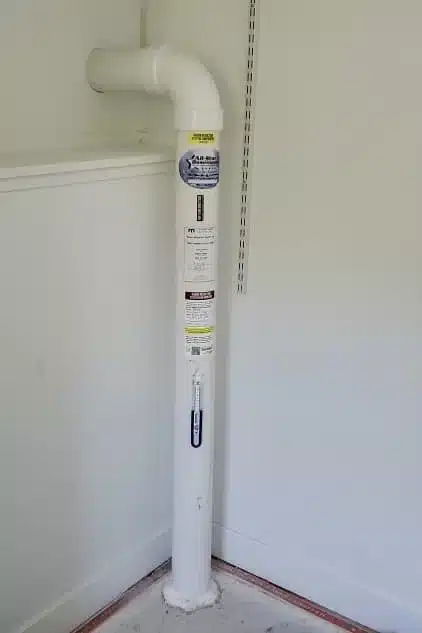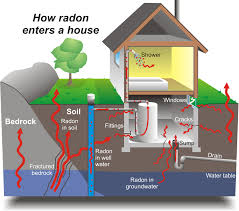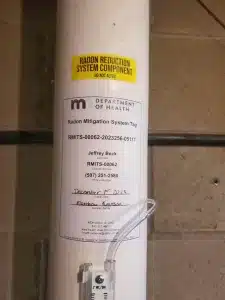
If radon is your concern, you are not alone. Radon mitigation can effectively lower this silent health risk in your home. Learn what systems work, how much they might cost, and how to maintain them for peace of mind in this complete guide.
Key Takeaways
-
- Radon is a colorless, odorless radioactive gas from natural uranium decay that poses health risks, including lung cancer and requires testing for detection and specialized mitigation systems to reduce indoor levels.
-
- Several types of radon mitigation systems are available—like Active Soil Depressurization, crawl space ventilation, and sealing and ventilation improvements—differing in efficacy, cost, and suitability based on home design and radon levels.
-
- Regular maintenance and testing post-installation are essential to ensure the long-term effectiveness of radon mitigation systems, with considerations also made for energy efficiency to reduce operating costs.
Understanding Radon and Its Dangers
Radon is a type of radioactive gas that occurs naturally and can have serious negative impacts on health. It is produced when uranium, thorium, and radium break down in rocks, soil, and water sources. This dangerous gas can enter homes through permeation and accumulate at levels that could pose significant risks. Even though it cannot be seen or smelled, radon exposure is closely linked with being the second highest cause of lung cancer after smoking.
To ensure a safer living environment for you and your family members, it’s essential to understand the potential dangers associated with radon exposure. Symptoms of poisoning from this harmful gas may include ongoing coughing fits as well as difficulties in breathing such as wheezing or chest pain. If any signs are present in individuals who have been exposed to high levels of radon over an extended period, they should seek immediate medical attention along with conducting a test for its presence within their home.
What is Radon?
Radon is a naturally occurring radioactive gas that comes from the breakdown of uranium in soil and rocks. It can be found underground, seeping into the air and water sources.
The danger arises when radon enters homes through cracks or gaps in foundations, leading to high levels of this odorless and invisible gas inside living spaces. To protect against radon exposure, it’s crucial to have effective mitigation systems installed. Since you cannot detect radon with your senses, testing is necessary to determine if your home has elevated levels requiring a mitigation system.
Health Risks Associated with Radon Exposure
High levels of radon gas exposure can have severe health consequences, particularly causing lung cancer. The breakdown of radon releases radioactive particles that enter the lungs when inhaled and cause harm. It is the leading cause of lung cancer among non-smokers and ranks second overall.
The danger increases for smokers who are exposed to radon, resulting in an estimated 21,000 deaths from radon-related lung cancer every year. While most research focuses on the link between lung cancers and high levels of exposure to this gas, other potential health risks remain understudied or unreported.
Identifying High Radon Levels in Your Home
Discovering high levels of radon in your home is possible through testing. There are two options available for homeowners, hiring a professional tester or using a test kit from the hardware store to conduct an independent test. The U.S. Environmental Protection Agency recommends taking action and mitigating radon if its level reaches 4 picoCuries per liter of air (pCi/L).
The cost of professional radon testing services typically ranges from $125 to $400 on average, with potential prices going up to $700 for larger homes. It is advised that homeowners should carry out this type of testing every two years and after any significant lifestyle changes or renovations as they can affect the presence of radon.
Types of Radon Mitigation Systems
Upon discovering a radon problem, your immediate course of action should be to reduce the levels of this harmful gas in your home. There are different types of systems available for mitigating radon, such as active soil depressurization systems, crawl space ventilation systems, and sealing and ventilation improvements.
These mitigation techniques can effectively decrease the concentration of radon in your home. It is crucial to have an understanding of their functioning so that you can choose the most suitable one based on factors like the construction style of your house, local climate conditions and current levels of radon.
Active Soil Depressurization Systems
ASD, also known as sub-slab depressurization, is a highly effective and commonly used method for mitigating radon levels. It involves the installation of a network of pipes along with a fan to draw air from the soil beneath your home. This decreases pressure in the soil and consequently reduces radon levels inside your home.
The ASD system requires components such as porous media or manifolds for distributing pressure and covering the soil. Although it is complex, this mitigation system has been proven to effectively lower radon levels. However, homeowners need to note that installing an ASD system can be invasive and disruptive to their homes.
Crawl Space Ventilation Systems
Proper ventilation systems in crawl spaces are essential for mitigating radon by removing gas, odors, and moisture. These systems function by preventing the entry of radon into the air within the crawl space and then expelling it outside.
To successfully mitigate levels of harmful gases such as radon in unvented crawl spaces, certain components must be present. These include a device for monitoring levels, a fan to facilitate airflow.
Pipes used for venting purposes and materials designed specifically to seal any gaps or openings.
Despite their effectiveness at minimizing exposure risks from pollutants like radon gas, improperly installed or designed ventilation can exacerbate problems with high concentrations.
Therefore, careful attention must be paid when determining proper encapsulation techniques along with appropriate strategies relating to venting methods to ensure success.
Sealing and Ventilation Improvements
Efforts to mitigate radon levels should include both sealing and ventilation enhancements. These measures involve closing off any openings, gaps, or fissures in the concrete foundation of a home to create a barrier that prevents radon from seeping inside. Improving airflow in areas like vented crawl spaces can also aid in decreasing indoor radon concentrations.
Boosting the overall ventilation of a house is crucial for lowering the presence of harmful radon gas. Bringing fresh outdoor air into an interior space, it helps dilute any existing contaminated air containing high amounts of this radioactive element. Incorporating these strategies within your plan for reducing exposure to elevated levels will significantly enhance its effectiveness against dangerous levels of airborne radon particles.
Factors Affecting Radon Mitigation System Costs
The cost of installing a radon mitigation system should consider several factors. These include the size and structure design of the house, the type and complexity of the chosen system, as well as its geographical location.
Bigger homes or those with intricate layouts may require more extensive measures for mitigating radon levels, which can result in higher costs. Complex systems often need specialized maintenance and customized designs tailored to fit specific home features, ultimately affecting their price tag. Varying labor rates and material expenses.
Home Size and Design
The cost of a radon mitigation system can be influenced by the size and structure of your home. This includes factors like its square footage, number of rooms, and layout. If you have a larger or more complexly designed home, it may require a higher level of mitigation in order to effectively reduce levels throughout the property. As such, homeowners should expect potential costs for comprehensive radon mitigation to range up to $3,000.
It’s important to note that not only does the size but also the design play an integral role in determining this expense as well. The type of foundation and construction materials used can impact how much effort is needed for effective reduction measures against harmful radon gas within your house. Thus affecting overall system expenses considerably.
System Type and Complexity
The overall cost of a radon mitigation system can vary depending on the type and complexity chosen. In general, more complex systems may require specialized maintenance and custom design to fit specific home needs, resulting in higher expenses.
Several factors influence the complexity of a radon mitigation system, including the building’s architectural structure, foundation type, and unique requirements for certain constructions such as multi-family buildings. These elements all play a role in determining how intricate the installation process will be and ultimately impact its cost.
Choosing the Right Radon Mitigation Professional
Ensuring that you choose the right professional to install your radon mitigation system is just as important as selecting the appropriate system. It’s crucial to verify that the person has proper certification and licensing, relevant experience, and can provide cost estimates along with warranties for their work.
To ensure a reputable radon mitigation service, it’s essential to confirm their certification through recognized organizations such as NRPP or state agencies. Consider researching their experience and reputation while also checking references from previous clients. Lastly, obtain a detailed estimate of costs and inquire about any potential warranties associated with installing the system.
Certification and Licensing
Hiring a licensed and certified radon mitigation professional is essential in guaranteeing high-quality services. These professionals have undergone proper training and education to effectively handle the issue of radon. You can verify their certification through trusted organizations like the National Radon Proficiency Program (NRPP) or state agencies.
To become a certified radon mitigation expert, one must complete a 16-hour initial training course on Radon Measurement, pass an approved test, and complete 24 hours of additional mitigation training. It is recommended to hire a licensed company to install your system as they ensure accurate testing and installation procedures.
Experience and References
When assessing a radon mitigation expert’s qualifications, consider their expertise with testing and abatement equipment for the detection of harmful levels of radon gas. Their communication skills and proficiency in using Microsoft Office Suite can also demonstrate their professionalism in managing and documenting the entire mitigation process.
To confirm references provided by a potential radon mitigation professional, ask for contact information from previous clients to inquire about their experience with the services received. Utilizing online resources such as state programs or EPA websites can provide access to lists of certified professionals along with additional client reviews.
Cost Estimates and Warranties
It is crucial to obtain estimates of cost when selecting a professional for radon mitigation. The estimate should factor in elements such as the size and age of your home, the expertise and reputation of the professional, and specific technical requirements needed for the mitigation system. Costs can range from $800 to $2,000 but may differ depending on these variables.
By providing detailed estimates along with warranties and guarantees regarding reducing radon levels through effective systems – professionals help ensure customers’ satisfaction while tackling potential health hazards related to elevated amounts of hazardous gas called Radon released into homes naturally by bedrock/geological features near them or human activities involving radioactive materials lying close underground surface layers usually found associated alongside certain minerals & ores etc around residential properties having substantially above average presence rates compared against national averages per Area–buildings— due mostly being located nearby areas where rocks expose significantly higher than normal uranium enrichment at depths deeper inside shallow crustal formations.
Maintaining Your Radon Mitigation System
Proper upkeep is crucial for ensuring the effectiveness of your radon mitigation system post-installation. This includes routine inspections, conducting radon testing after installation, and prioritizing energy efficiency.
Regular maintenance checks are essential in monitoring the proper functioning of all components within the system and identifying any necessary repairs or upgrades. It is recommended to conduct radon testing every two years, with more frequent tests if there have been lifestyle changes or home renovations. Considering ways to improve energy efficiency can help keep utility costs low while still maintaining a safe living environment free from harmful levels of radon gas.
Routine Inspections
Regularly checking your radon mitigation system is crucial to ensure its continued efficient operation. The EPA recommends conducting tests on existing systems every two years. During these evaluations, it’s important to assess the functionality of fans, look for any missing parts, and visually inspect the entire system.
If any problems are found during the inspection, prompt action should be taken. Obtain a quote from certified contractors experienced in handling radon mitigation systems and follow established quality assurance procedures to effectively address any issues that arise.
Radon Testing After Installation
It is essential to conduct a follow-up radon test after installing the mitigation system. This ensures that the system effectively reduces levels of radon in the environment and protects your family from its health risks. You can use do-it-yourself kits or hire a professional tester for this purpose.
Testing should be done every two years, or more frequently if there are changes in lifestyle habits or home renovations that could impact radon levels. Regular testing guarantees the continued effectiveness of your mitigation system in reducing and maintaining safe levels of radon inside your home.
In conclusion, safeguarding our homes against the silent threat of radon is an imperative step towards ensuring the health and well-being of our families. This article has provided a comprehensive guide to effective radon mitigation strategies, emphasizing the critical importance of understanding radon’s nature, its potential health risks, and the diverse systems available for reducing indoor radon levels. With lung cancer being a significant consequence of radon exposure, the need for regular testing, thoughtful system selection, and vigilant maintenance cannot be overstated.
Choosing the right radon mitigation professional is pivotal, and the considerations of certification, experience, and detailed cost estimates are vital in this process. Moreover, the commitment to routine inspections and follow-up testing after installation is key to guaranteeing the continued efficacy of mitigation systems. By integrating these measures into our homes, we not only address the immediate risk of radon exposure but also contribute to creating safer, healthier living spaces for ourselves and future generations. In the quest for a secure home environment, awareness and proactive mitigation are the cornerstones for mitigating the insidious threat of radon.

All-Star Basements is Locally Owned and Operated and based out of Rochester, Minnesota. We cover Southern Minnesota including the Twin Cities area, Western Wisconsin and parts of Northeast Iowa. Our team is committed to solving our customers’ basement waterproofing, foundation repair, or crawl space needs and offering multiple solutions to choose from.
As a proud member of the Basement Health Association and the National Waterproof Members of America, we have the best products available to solve your leaky basement, seepage, or flooding issues. Our lineup also includes multiple crawl space solutions.
If you have foundation problems that need any kind of repair, we can help! We feature the nationally renowned Grip-Tite Foundation Systems, which has a long history over 90 years of fixing homeowners’ foundation repair issues- from walls that are buckled, tipping or cracked and bowing.
At All-Star Basements, we are committed to providing multiple solutions to choose from to help fix any basement problem you may have. We are very proud of our Better Business Bureau A+ rating and take great pride in caring for all of our customers’ needs- big or small, we do it all!